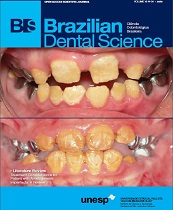Cuspal deflection of directly or indirectly restored teeth
DOI:
https://doi.org/10.14295/bds.2013.v16i4.899Abstract
Objective: The aim of this study was to evaluatethe cuspal deflection of teeth restored directlyand indirectly. Material and Methods: Fortysound maxillary premolar teeth were restoredwith composite and different base materials. Widemesial-occlusal-distal cavity preparations wereperformed, with isthmus width of one third of thedistance between the cuspal tips, 3 mm occlusaland a 5 mm interproximal preparation height. Theteeth were divided into 4 groups (n = 10), accordingto the restoration type: G1) GIC-DCR (1 mm glassionomer cement base and direct restoration usingnanoparticulate composite); G2) FL-DCR (1 mm baseof flowable composite resin and direct restorationusing nanoparticulate composite); G3) GIC-ICR(1 mm glass ionomer cement base and indirectrestoration using nanoparticulate composite GICbase); G4) FL-ICR (1 mm base of flowable compositeresin and indirect restoration using nanoparticulatecomposite). The specimens were submitted tocompressive load of 50 N on the buccal and lingualcusps, in a universal testing machine. The lingualcusp microstrain (??) measurements were executedby strain gauges. Results: The Kruskal-Wallis (5%)test was used and showed there were no significantdifferences among the microstrain values for the fourstudy groups (G1 = 1250; G2 = 1075; G3 = 1279;G4 = 937). Conclusion: It could be concluded thatthe restorative techniques and the bases employeddid not show any influences in cuspal deflection.
Keywords
Base materials; Cuspal defection; Composite resin; Direct restoration; Indirect restoration.
Downloads
Downloads
Published
How to Cite
Issue
Section
License
Brazilian Dental Science uses the Creative Commons (CC-BY 4.0) license, thus preserving the integrity of articles in an open access environment. The journal allows the author to retain publishing rights without restrictions.
=================




























